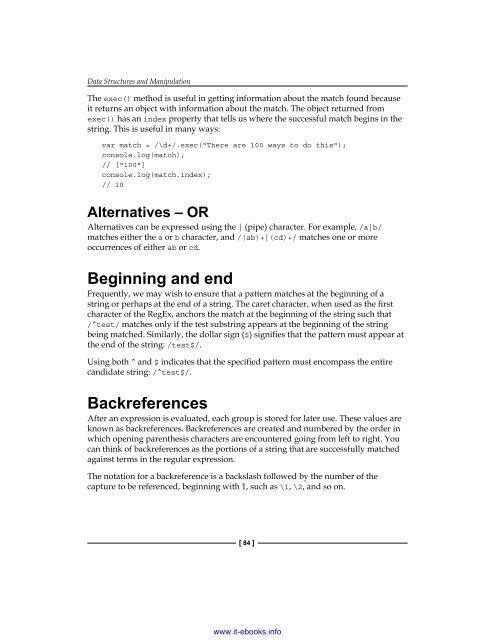Create successful ePaper yourself
Turn your PDF publications into a flip-book with our unique Google optimized e-Paper software.
Data Structures and Manipulation<br />
The exec() method is useful in getting information about the match found because<br />
it returns an object with information about the match. The object returned from<br />
exec() has an index property that tells us where the successful match begins in the<br />
string. This is useful in many ways:<br />
var match = /\d+/.exec("There are 100 ways to do this");<br />
console.log(match);<br />
// ["100"]<br />
console.log(match.index);<br />
// 10<br />
Alternatives – OR<br />
Alternatives can be expressed using the | (pipe) character. For example, /a|b/<br />
matches either the a or b character, and /(ab)+|(cd)+/ matches one or more<br />
occurrences of either ab or cd.<br />
Beginning and end<br />
Frequently, we may wish to ensure that a pattern matches at the beginning of a<br />
string or perhaps at the end of a string. The caret character, when used as the first<br />
character of the RegEx, anchors the match at the beginning of the string such that<br />
/^test/ matches only if the test substring appears at the beginning of the string<br />
being matched. Similarly, the dollar sign ($) signifies that the pattern must appear at<br />
the end of the string: /test$/.<br />
Using both ^ and $ indicates that the specified pattern must encompass the entire<br />
candidate string: /^test$/.<br />
Backreferences<br />
After an expression is evaluated, each group is stored for later use. These values are<br />
known as backreferences. Backreferences are created and numbered by the order in<br />
which opening parenthesis characters are encountered going from left to right. You<br />
can think of backreferences as the portions of a string that are successfully matched<br />
against terms in the regular expression.<br />
The notation for a backreference is a backslash followed by the number of the<br />
capture to be referenced, beginning with 1, such as \1, \2, and so on.<br />
[ 84 ]<br />
www.it-ebooks.info


